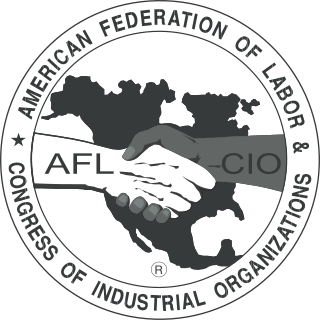
The American Federation of Labor and Congress of Industrial Organizations (AFL–CIO) is the largest federation of unions in the United States. It is made up of 60 national and international unions, together representing more than 12 million active and retired workers. The AFL–CIO engages in substantial political spending and activism, typically in support of progressive and pro-labor policies.

The American Federation of Labor was a national federation of labor unions in the United States that continues today as the AFL–CIO. It was founded in Columbus, Ohio, in 1886 by an alliance of craft unions eager to provide mutual support and disappointed in the Knights of Labor. Samuel Gompers was elected the full-time president at its founding convention and was re-elected every year except one until his death in 1924. He became the major spokesperson for the union movement.

Jay Lovestone was an American activist. He was at various times a member of the Socialist Party of America, a leader of the Communist Party USA, leader of a small oppositionist party, an anti-Communist and Central Intelligence Agency (CIA) helper, and foreign policy advisor to the leadership of the AFL–CIO and various unions within it.

William George Meany was an American labor union leader for 57 years. He was the key figure in the creation of the AFL–CIO and served as the AFL–CIO's first president, from 1955 to 1979.
Thomas Reilly Donahue Jr. was an American trade union leader who served as Secretary-Treasurer of the American Federation of Labor and Congress of Industrial Organizations from 1979 to 1995, interim president for several months in 1995, and was President Emeritus from 1996 until his death. He was considered one of the most influential leaders of the post-World War II American trade union movement.

Matthew Woll was president of the International Photo-Engravers Union of North America from 1906 to 1929, an American Federation of Labor (AFL) vice president from 1919 to 1955 and an AFL-CIO vice president from 1955 to 1956.
International Molders and Foundry Workers Union of North America was an affiliated trade union of the AFL–CIO. The union traced its roots back to the formation of the Iron Molders' Union of North America, established in 1859 to represent craftsmen who cast wrought iron metal products. It is now part of the GMP International Union.
The International Typographical Union (ITU) was a US trade union for the printing trade for newspapers and other media. It was founded on May 3, 1852, in the United States as the National Typographical Union, and changed its name to the International Typographical Union at its Albany, New York, convention in 1869 after it began organizing members in Canada. The ITU was one of the first unions to admit female members, admitting women members such as Augusta Lewis, Mary Moore and Eva Howard in 1869.

The Seafarers International Union or SIU is an organization of 12 autonomous labor unions of mariners, fishermen and boatmen working aboard vessels flagged in the United States or Canada. Michael Sacco has been its president since 1988. The organization has an estimated 35,498 members and is the largest maritime labor organization in the United States. Organizers founded the union on October 14, 1938. The Seafarers International Union arose from a charter issued to the Sailors Union of the Pacific by the American Federation of Labor as a foil against loss of jobs to the Congress of Industrial Organizations (CIO) and its Communist Party-aligned faction.
The Labor Council for Latin American Advancement (LCLAA) is a nonprofit, nonpartisan Latino organization affiliated with the AFL-CIO and the Change to Win federation. It was founded in 1972 to provide Latino trade union members in the United States with a more effective voice within the AFL-CIO, to encourage Latino participation in the democratic process, and to encourage the organization of Latino workers into labor unions.
The United Public Workers of America (1946–1952) was an American labor union representing federal, state, county, and local government employees. The union challenged the constitutionality of the Hatch Act of 1939, which prohibited federal executive branch employees from engaging in politics. In United Public Workers of America v. Mitchell, 330 U.S. 75 (1947), the Supreme Court of the United States upheld the Hatch Act, finding that its infringement on the Constitutional rights was outweighed by the need to end political corruption. The union's leadership was Communist, and in a famous purge the union was ejected from its parent trade union federation, the Congress of Industrial Organizations, in 1950.

James Barron Carey was a 20th-century American labor union leader; secretary-treasurer of the Congress of Industrial Organizations (CIO) (1938–55); vice-president of AFL–CIO ; served as president of the United Electrical Workers (UE) (1936–41) but broke with it because of its alleged Communist control. He was the founder and president (1950–65) of the rival International Union of Electrical, Radio and Machine Workers. President Truman appointed Carey to the President's Committee on Civil Rights in 1946. Carey was labor representative to the United Nations Association (1965–72). Carey helped influence the CIO’s pullout from the World Federation of Trade Unions (WFTU) and the formation of the International Confederation of Free Trade Unions (ICFTU) dedicated to promoting free trade and democratic unionism worldwide.

The Pennsylvania AFL–CIO is a federation of labor unions in the U.S. state of Pennsylvania in the United States. It is an affiliate of the AFL–CIO. It was formed on June 9, 1960, by the merger of two predecessor bodies, the Pennsylvania Federation of Labor and the Pennsylvania Industrial Union Council. It can trace its history through its predecessor bodies to 1890.

The Congress of Industrial Organizations (CIO) was a federation of unions that organized workers in industrial unions in the United States and Canada from 1935 to 1955. Originally created in 1935 as a committee within the American Federation of Labor (AFL) by John L. Lewis, a leader of the United Mine Workers (UMW), and called the Committee for Industrial Organization. Its name was changed in 1938 when it broke away from the AFL. It focused on organizing unskilled workers, who had been ignored by most of the AFL unions.

North America's Building Trades Unions (NABTU) is a labor federation of 14 North American unions in the building trade, founded by the American Federation of Labor in 1907.
The first-ever "political action committee" in the United States of America was the Congress of Industrial Organizations – Political Action Committee or CIO-PAC (1943–1955). What distinguished the CIO-PAC from previous political groups was its "open, public operation, soliciting support from non-CIO unionists and from the progressive public. ... Moreover, CIO political operatives would actively participate in intraparty platform, policy, and candidate selection processes, pressing the broad agenda of the industrial union movement."
The United Office and Professional Workers of America (UOPWA) (1937–1950) was a CIO-affiliated union and one of the white-collar unions formed by the CPUSA-breakaway party of Lovestoneites.
Max Zaritsky (1885–1959) was an American union leader of the United Hatters, Cap and Millinery Workers International Union (UHCMW) as well as co-founder of both the American Labor Party and Liberal Party of New York State.
The United Rubber, Cork, Linoleum and Plastic Workers of America (URW) was a labor union representing workers involved in manufacturing using specific materials, in the United States and Canada.









